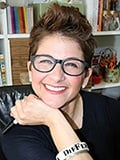
Small Changes, Big Differences: In this series, Meg Lemke interviews leading thinkers in education to ask them what small changes can make the biggest difference in student learning.
“When you know where you are going, it’s easier to get there,” says Samantha Bennett, literacy expert and professional development leader. We asked her to name one small change she thinks could make a big difference in education. Her answer: “planning backwards.” It’s a concept that may seem obvious—we do it every day, walking out of the door. You need to think about where you want to go, and then set your direction to get there. But what is intuitive can be trickier in execution. By the time we get to classrooms, we’re still too often getting lost.
This article is one of the many articles, books, videos and resources from Heinemann authors available in Heinemann’s Digital Library. For more information visit: Heinemann.com/PD/DigitalLibrary or call 800.541.2086 x1100
How can teachers “plan backwards” (Wiggins and McTighe) as they develop a curriculum and classroom approach? First, define the learning goal we want students to reach. Then consider what motivates meaningful learning, to build scaffolding that learners are capable and eager to climb themselves. Here’s a downloadable reference on planning backwards that can help you with this work.
In most school settings today, “meaningful learning” translates to The Common Core Standards. But, it’s “messy,” as Bennett says. What do we want for students at the end of the day, the year, and in their adult lives—for them to grow into life-long learners, who are engaged, successful, and active for the greater good? You don’t want to lose the forest for the trees. Bennett has criticisms of their application, but does believe that “the Common Core standards derive from high-quality work in the world and having/creating a meaningful life that serves the individual and society simultaneously.” But in isolating the components of this work, the authors of the standards “didn’t start with the ‘parts,’ they start with the whole….Teachers should do the same. The parts don’t matter without a clear vision of the whole.”
Give Students Reasons
As Bennett coaches, “When you plan backwards, no day lives in isolation and no skill lives in isolation. In your writing instruction, for example, you may be focusing for a day or two (or three or four) on ‘introducing a precise claim’ (CC W.9.1a), but that day is nested in a plan that offers a compelling reason to write an argument with a real world audience in mind, time to research your topic, and interview sources, all before making a claim, [and] analyzing mentor texts for a variety of ways other authors both define and introduce a precise claim… It all lives within a complete package of a reason to write an argument, an audience to write it for.”
The starting point on the map: student engagement. You can draw a path but students need to walk it. Bennett’s favorite organizing tools for planning backwards are keeping “the 4 Ts” in mind. That’s: Compelling topics, texts, tasks, and targets (Transformational Literacy 2014).
Let’s consider a learning goal as lofty as engaged citizenship—or a more day to day goal such as knowing how to write a persuasive letter. Actually, these could be the same target. Teacher Laura Harney’s class was doing a biology unit on Ebola—and its “effects on the body and the world.” Focusing on real-world applications, her student, Carrie, engaged in independent research to identify an anti-rape outreach organization, NO MORE. Carrie wrote them a letter, calling on the nonprofit to help young girls in Liberia who had been displaced from schools due to the Ebola outbreak, who were at increased risk for sexual assault. She provided statistics and documentation. She used specialized vocabulary in accurate context, and demonstrated professional writing conventions while infusing her letter with a passionate personal voice. NO MORE wrote back, “It sounds like you have really done your research!” and invited her to use a host of tools their organization provides to run her own campaign. The letter was a literacy exercise—but the conversation continued, and honored the student’s agency. You could see the student learning to write in a school context, and the citizen learning to live in the world.
Give Students Time to Practice What Matters Most
It’s a huge challenge, determining how to get reluctant writers going. And, once they start, how to keep them at it… As you plan backwards, pause at each point to consider: how much time do students need to practice what matters most? This is where we often underestimate. Bennett’s research and experience has shown her that “students aren’t getting enough time to write. Period. Nothing else matters.” How can we engage students for the maximum number of minutes each day? It takes “10,000 hours to become an ‘expert,’ at anything,” cites Bennett from the Research from Cambridge Handbook of Expertise. Writing takes practice, and practice takes time. Ultimately, she believes, “none of the smaller targets/standards matter. How coherent, cohesive writing happens is a magical combination of whole and parts and parts and whole—until students get more time to practice and reasons to write that they care about, their writing will not improve or ever have an impact on a reader, AND the scores won’t go up.”
Focus on Learning Goals—Not High-Stakes Tests
Ok, you might be thinking, I can write a goal on the calendar, and then plan backwards—blocking in the daily tasks and student time. But where does that teaching time go, now? (Could we get it back?) Samantha Bennett reports that her eighth-grade son will spend nine days this school year taking standardized tests. “They will have no impact on his life, other than wasting his time.” Bennett calls tests out as “fake tasks that have no bearing on the kinds of skills he will need to survive and thrive in our complex society.”
Bennett wishes we could give all that testing and test-prep time back to teachers—and coach them to use it to plan backwards. Standardized assessments are not going to transform with “one small change.” But let’s hear what she’s saying—how the expectations and high-stakes pressures they exert have had too great a role in shaping our curriculum. These tests are “not the true purpose of education,” argues Bennett, while schools spend “an inordinate amount of human and financial resources on testing, and just assume that good instruction will be prompted by the success/failure rates on the tests.”
Samantha Bennett’s vision is for schools to support teachers as they focus on “planning with an end in mind that is worthy of students extended time and attention, and figuring out how to help students stay engaged for the maximum number of minutes each day—so more students will get there.”
Planning Backwards: A Resource List
- Understanding by Design, Wiggins and McTighe (ASCD)
- The Cambridge Handbook of Expertise, Ericsson, Charness, Feltovich, and Hoffman (Cambridge University Press 2006)
- Common Core Unit by Unit, Cheryl Dobbertin (Heinemann 2013)
- That Workshop Book, Sam Bennett (Heinemann 2007)
- Reading with Meaning, 2nd Edition, Debbie Miller (Stenhouse 2012)
- So What Do They Really Know? Cris Tovani (Stenhouse 2011)
- Classroom Assessment for Student Learning, Jan Chappuis and Rick Stiggins (Pearson 2011)
- Focus: Elevating the Essentials to Radically Improve Student Learning, Mike Schmoker (ASCD 2011)
- Leaders of their Own Learning, Berger and Rugen (Jossey Bass 2014)
- Transformative Literacy, Berger, Woodfin, Plant, and Dobbertin (Jossey Bass 2014)
- Culture of Quality, Ron Berger (Annenberg Institute 2011)
♦ ♦ ♦ ♦
 Samantha Bennett is the author or coauthor of four Heinemann resources: "Everyday Habits that Grow Successful Readers" and "Adolescent Reading RX," courses on the Heinemann Digital Campus; Comprehension Going Forward; and That Workshop Book.
Samantha Bennett is the author or coauthor of four Heinemann resources: "Everyday Habits that Grow Successful Readers" and "Adolescent Reading RX," courses on the Heinemann Digital Campus; Comprehension Going Forward; and That Workshop Book.
Sam is the former instructional coach at the Rocky Mountain School of Expeditionary Learning. Previously she was a staff developer with the Denver-based Public Education and Business Coalition, a middle school social studies teacher, a curriculum-technology integration specialist, a district literacy specialist, an adjunct professor at the University of Colorado at Denver, and lab-facilitator for Cris Tovani. She works closely with teachers at her school and across the country to help them tap into the energy to teach and learn.
Sam is branching into systems-level work and helping districts set up a variety of coaching and professional development structures to support teachers, including the Lab Model pioneered by the PEBC. Sam is currently researching and writing about giving students access to power in the world through the creation of meaningful work in school.
She gets her energy from her husband Maurice and their three sons—Charlie, Theo, and Augie.
 Meg Lemke is a writer, editor, and parent concerned about schooling for all children. She is Editor at MUTHA Magazine (www.muthamagazine.com), oversees comics and graphic novel programming at the Brooklyn Book Festival (brooklynbookfestival.org), and her writing and interviews have been published in The Paris Review, Seleni, The Good Mother Myth blog, The Seattle Review, The Atlanta Review, and elsewhere. She lives with her family in Brooklyn, NY. Find her on Twitter @meglemke and on Tumblr.
Meg Lemke is a writer, editor, and parent concerned about schooling for all children. She is Editor at MUTHA Magazine (www.muthamagazine.com), oversees comics and graphic novel programming at the Brooklyn Book Festival (brooklynbookfestival.org), and her writing and interviews have been published in The Paris Review, Seleni, The Good Mother Myth blog, The Seattle Review, The Atlanta Review, and elsewhere. She lives with her family in Brooklyn, NY. Find her on Twitter @meglemke and on Tumblr.
*Photo by Elly Filho


